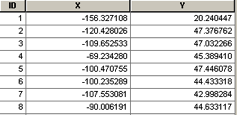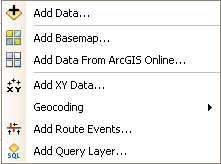See the page ‘training‘ to read about options for GIS training from ESRI (available to Michigan Tech students, faculty, and staff at no cost).
Author Archives: mdhyslop_gis
Using GIS to determine stream sinuosity
Sinuosity is a measure of how much a river (or other linear feature) deviates from being straight. A truly straight river or road has a sinuosity of 1; as the number of meanders increases, sinuosity approaches 0.
I wrote a document describing how to determine the sinuosity of linear features years ago. I will update it for ArcGIS 10 as time permits, but the original document, written for ArcView 3.x and ArcGIS 8x/9x is available here.
Importing x,y data into ArcGIS
Importing a set of x,y coordinate pairs into ArcGIS is very straightforward, and can be a useful skill if you need to bring in simple coordinate data that is not already in a spatial format.
1) Acquire some data you want to display on a map. The source doesn’t matter: it might be locations recorded on a GPS unit that you don’t have a data cable for, coordinates determined from a topographic map, or a simple data set found on the internet. If you want your locations to integrate correctly with other layers (always a good thing in GIS) you will need to know both the coordinate system and datum used by the source data, e.g. latitude / longitude and NAD27.
2) Format your data properly. This may be done in a spreadsheet program such as Google Spreadsheets <spreadsheets.google.com>, or the more ubiquitous Excel. To import properly into ArcGIS, your data file will require a minimum of three fields: a unique identifier for each data point, and the X (easting) and Y (northing) for each location. Other attribute data, if available, may go into additional columns, but your points will import fine with just these three pieces of information. Your file should also contain a header line that describes each field. It might be as simple as ID, X_coord, Y_coord. Additional fields are OK, but descriptions in each header are limited to seven characters and cannot have special characters or spaces. If you need spacing for readability, use underscores.

Be sure if you are using latitude/longitude coordinates that your northings are positive if north of the equator and eastings are negative if you are in the western hemisphere. Example: the coordinates for a location in Houghton, Michigan are -88.54820, 47.11535 in latitude/longitude and 382552, 5219145 in UTM zone 16, NAD 1983 datum. Omitting the “-” sign will put your points on the wrong side of the globe.
If your coordinates are in latitude/longitude, they should be in decimal degrees (DD) format before importing into ArcGIS. Locations in degrees, minutes and seconds (DMS) or decimal minutes (DM) format should first be converted to DD. There are converters available on the internet, but it is probably quicker to use Excel to perform the conversion.
D = Degrees M = Minutes S = Seconds .m = Decimal Minutes .s = Decimal Seconds
DM.m = Degrees, Minutes, Decimal Minutes (eg. 45°22.6333)
D.d = Degrees, Decimal Degrees (eg. 45.3772°)
DMS = Degrees, Minutes, Seconds (eg. 45°22’38”)
DMS –> DM.m (45°22’38” –> 45°22.6333)
◦ Divide S by 60 to get .m (38/60=.6333)
◦ Add .m to M to get M.m (22+.6333=22.6333)
DM.m –> D.d (45° 22.6333 –> 45.3772)
◦ Divide M.m by 60 to get .d (22.6333/60=.3772)
◦ Add .d to D to get D.d (45+.3772=45.3772)
D.d –> DM.m (45.3772 –> 45°22.6333
◦ Multiply .d by 60 to get M.m (.3772*60=22.6333)
DM.m –> DMS (45°22.6333 –> 45°22’38”)
◦ Multiply .m by 60 to get S(.6333*60=38)
DMS–>DD
◦ D + M/60 + S/3600 = DD
3) Save/export your data as a comma-delimited text file (CSV format in Google Spreadsheets or Excel). You may want to save a copy in native format (.xls in both Google spreadsheets and Excel) before exporting to .csv.
4) Add your .csv file to ArcMap by using the Add data tool (either by expanding the submenu under File> Add Data)  or by clicking the Add Data tool on the Standard toolbar
or by clicking the Add Data tool on the Standard toolbar ![]()
5) Right-click on your new layer and choose Display XY Data… Ensure that the X and Y fields were selected correctly by ArcMap – they should be right if you chose names that reflect the coordinate positions (northing and easting or x and y). Click the Edit… button, then Select… to select the coordinate system for your points, Add… and OK (3x). The correct coordinate system to use may be obtained from your GPS unit (under map setup or units); from the marginal information on your topo map; or from the metadata file that came with internet data. Look in geographic coordinate systems for latitude/longitude projection files, or in projected coordinate systems > UTM for UTM data.
Some possible suggestions:
- Coordinate Systems > Geographic Coordinate Systems > World > WGS1984.prj (default GPS datum)
- Coordinate Systems > Geographic Coordinate Systems > North America > NAD1983.prj (current North American datum)
- Coordinate Systems > Projected Coordinate Systems > UTM > NAD1983 > NAD 1983 UTM Zone 16N.prj (appropriate for most of the U.P.)
- Coordinate Systems > Projected Coordinate Systems > State Systems > NAD 1983 Michigan GeoRef (Meters).prj (projection and datum used by the State of Michigan)
6) You should now have a point layer at the top of your Table of Contents with the same name as your .csv file and the word Events on the end of the name.
This is an “event theme” and is a temporary layer. If you want a more permanent copy, right-click on the layer and choose Data > Export Data… Pick an output location—a geodatabase feature class or a directory for a shapefile—and enter a file name. Please change the name to something other than the default Export_Output – I suggest one that more accurately reflects the contents of the data layer. Click OK.
You now have a permanent layer, either a geodatabase feature class or shapefile, of your original ASCII (text) coordinates.
Assessing foodsheds in ArcGIS
From the latest ArcUser magazine: using ArcGIS to assess the path taken by food from its source to consumers in Chicago. Read the online article or a PDF
Geocoding in ArcGIS Online
Geocoding is the process of interpolating a location from an address. Data used in geocoding does not have a spatial location (coordinates) and is usually stored in a database or spreadsheet.
ESRI has developed a tutorial for ArcGIS Online that shows how to perform geocoding. It is available here.
ESRI white paper: LiDAR in forestry applications
A 50-page white paper on the use of LiDAR in natural resource and forestry applications (creating DEMs, tree height modeling, mosaicing, and more) is available from ESRI, here.
GIS-based flood forecasting model
Found at GIS and Science:
http://gisandscience.com/2011/10/12/gis-based-multidate-flood-forecasting-using-hydraulic-model/
The full paper is available here
GIS with Open Street Map and R
I may occasionally publish links to ‘how-to’ posts from elsewhere. I recently came across the information linked below.
OpenStreetMap is a free, editable world map (spatial database). Data from the project may be used in GIS software or uploaded to a map-capable GPS unit.
The R Project for Statistical Computing is the home of R (aka Gnu S) — a free, open source statistics package that has gained a substantial following in recent years. R is multiplatform and has a large, active developer base. There are many example scripts and a copious amount of tutorial information available online to help you learn R.
The blog post found here is entitled Visualizing GIS data with R and Open Street Map. The tutorial uses free software and data for mapping. Enjoy.
3-D GIS-based landslide prediciton
Coupling 3D GIS-based Modelling and Field Methods to Evaluate Landslide Hazard Predisposition
found at GIS and Science – a great resource for recent geospatial research (papers, presentations, abstracts)
Google Earth downloaded over 1 billion times
Google’s LatLong blog announced Wednesday that Google Earth products have been downloaded over 1 billion times. There are some interesting stats and useful links in the post.
